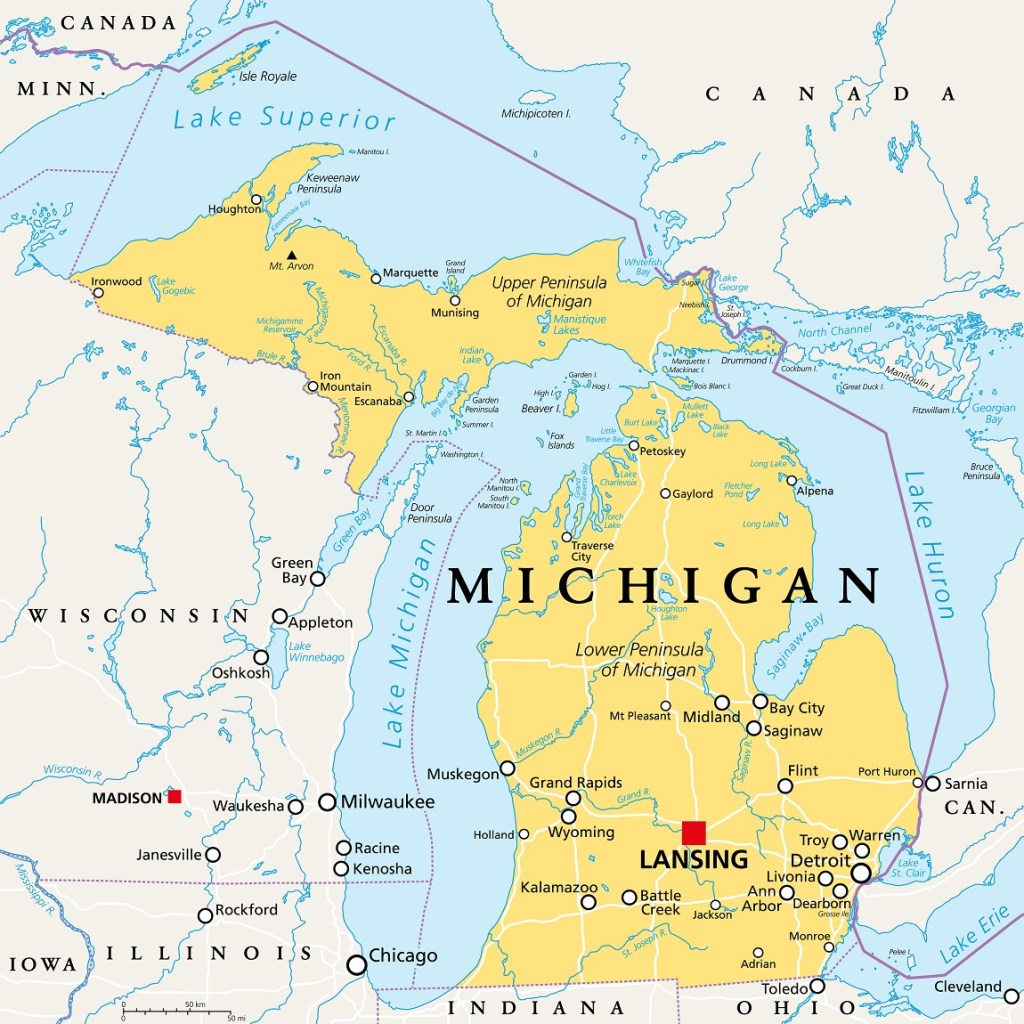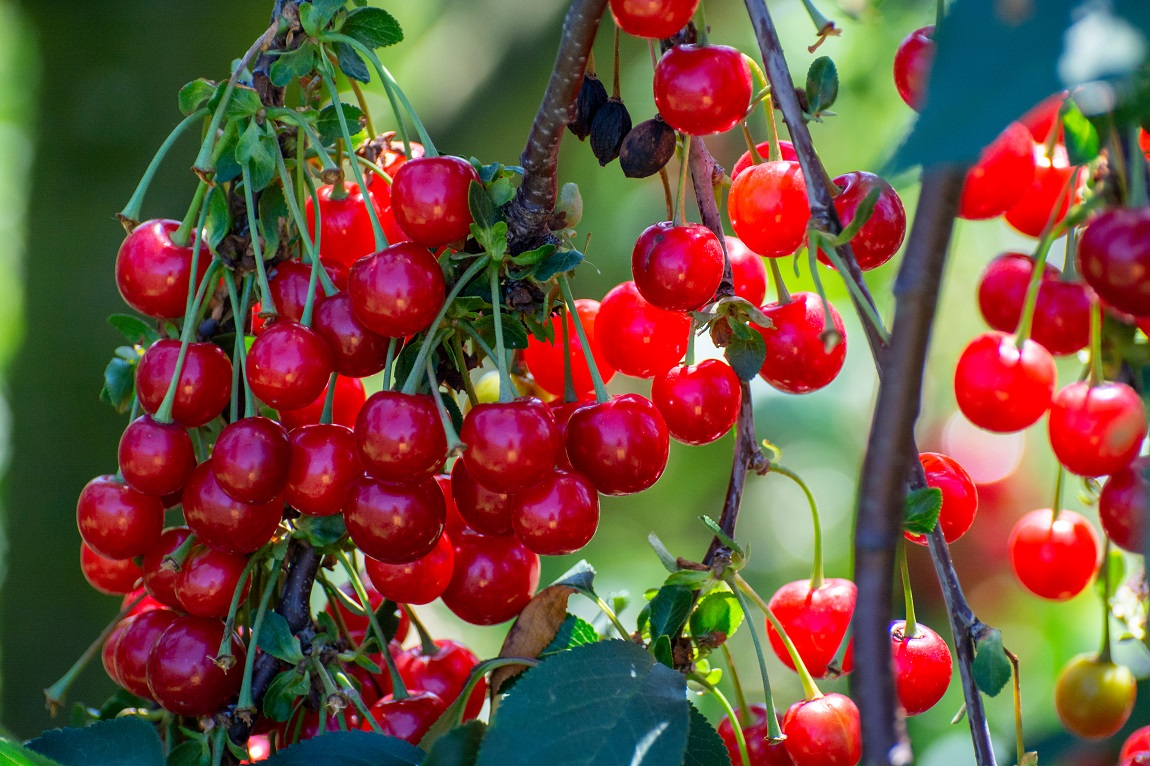Specialty Crop Powerhouse of the North
For those who might be new to our company blog, we are in the middle of a tour of U.S. agriculture. On our journey we have been examining not only the production capacity, but also the unique set of crops grown commercially in each of the 50 states. We also seek to at least scratch the surface of each respective state’s research support system at its associated land-grant university (LGU) because it reflects the state’s agricultural footprint and helps to make farming possible and profitable. By our count, this is the 22nd stop on our nationwide tour and it has been a fascinating trek thus far. Our next stop on our America’s Best Idea tour is no exception, for to understand what Michigan can produce we must first understand Michigan’s unique geographical features.
Water has always had a moderating influence on temperatures, which is no great secret and helps to explain why human populations tend to flock there. While this might attract people, it can also have very real impacts on agriculture, which of course is susceptible to things like extreme temperatures, frost damage, and precipitation. Take, for example, the total number of crops per state. In coastal states, the number of different crops commercially produced typically numbers in the hundreds. Meanwhile, in the U.S. interior, that number is typically in the dozens. For instance, 100 percent of commercial strawberry production in 2017 came from California, Florida, Oregon, North Carolina, Washington, and New York, in order of production according to the U.S. Department of Agriculture. That’s not to say strawberries can’t grow in Kansas, it’s just that you’d be hard pressed to find a commercial strawberry farmer in Kansas. Of course, proximity to major bodies of water is clearly not the only factor in the number of crops to be grown, but it is a significant one and deserves special attention.

If only we had a case study where we could see agricultural production in the continental interior that is surrounded by water. Fortunately for us, we have Michigan, which consists of two peninsulas and touches four of the five Great Lakes (see image). On a side note, in Michigan you will find a subset of the population known more casually as Yoopers. What’s a Yooper? A Yooper is a resident of Michigan’s Upper Peninsula, or UP, as in “UPer,” or “You-Per,” to be phonetically correct. Residents of the UP, er, Yoopers, even celebrate an annual Yooper Day on September 6, which is a reference to their 906 area code. But back to Michigan…er, the Lower Peninsula.
The effect of the Great Lakes on Michigan’s climate is significant. In the third installment in a series called Great Lakes Literacy, the Michigan State University (MSU) Extension discusses this very concept.
The Great Lakes modify the local weather and climate. Because water temperatures change more slowly than land temperatures, lake waters gain heat in summer and release heat during cooler months. This results in cooler springs, warmer falls, delayed frosts and lake-effect snow.
https://www.canr.msu.edu/news/great_lakes_literacy_principle_three_the_lakes_influence_local_and_regional
At a macro level, this makes Michigan much more inviting to a more diverse agricultural landscape than you would typically expect in the Midwest. In fact, the Michigan Farm Bureau boasts of more than 300 crops grown in the state and second only to California. To the immediate south, meanwhile, Indiana’s Department of Agriculture touts that “more than 30 major fruits and vegetables” are grown in the state each year. While we don’t know the specific methodology used to arrive at those numbers, a 10-fold disparity is substantial and reflects a unique capacity for a diverse agricultural landscape found in Michigan that most other states simply do not have.
With that overview as background, let’s take a closer look at some more unique aspects of Michigan agriculture. Nationally, corn and soybeans far outpace all other crops and as a Midwest state, Michigan is no different. In fact, corn is the state’s number one crop with a value of $1.8 billion in 2021, according to the USDA National Agricultural Statistics Service, and good enough for 12th nationally. Soybeans, at $1.5 billion, rank 13th by value. Michigan also grows plenty of small grains, including wheat ($281 million, 13th), oats ($5 million, 14th), and barley ($1.8 million, 19th).
But to get to anything approaching 300 crops, a state has to produce more than row crops, and to suggest that Michigan is a major player in the specialty crop sector would be a massive understatement. From asparagus ($23 million, 1st) to zucchini ($40 million, 2nd), Michigan’s contributions to the U.S. specialty crop production is quite impressive. Michigan’s apple production in 2022 is estimated to reach 29.5 million bushels and a value of more than $200 million, placing it behind only Washington and New York. Blueberries (73 million pounds, 4th), tart cherries (97 million lbs, 1st), cucumbers ($52.5 million, 2nd), snap beans ($24 million, 5th), cabbage ($22.7 million, 7th), pumpkins ($15 million, 8th), bell peppers ($14.5 million, 6th), potatoes ($253 million, 6th), and it is one of only seven states reporting maple syrup production ($6.9 million). The list goes on and on. And while we cannot possibly list everything here, we can point you to Michigan’s Department of Agriculture and Rural Development website and a helpful Facts and Figures report for more information.
With a substantial agricultural portfolio to support, Michigan’s oldest LGU–Michigan State University (MSU) in East Lansing–represents a key institutional support mechanism for the state. Founded in 1855 as the Agricultural College of the State of Michigan, the university went through four name changes before settling on Michigan State University in 1964. Its College of Agriculture and Natural Resources (CANR) is one of 17 colleges within the university and is MSU’s first.
MSU’s CANR includes the Graduate Program in Plant Breeding, Genetics, and Biotechnology (PBGB) that operates under the direction of Dr. David Douches, who is also one of the leading potato breeders in the U.S. and with whom we’ve had the opportunity to interact with on several occasions. Other breeding activities include dry bean breeding under the guidance of Dr. Francisco Gomez and USDA Agricultural Research Service (ARS) scientist Dr. Karen Cichy who leads the USDA-ARS Food Legume Quality Genetics Lab in East Lansing. The USDA-ARS facility also focuses on sugarbeet research under the guidance of Dr. Rachel Naegele. The MSU Wheat Breeding and Genetics program operates under the leadership of Dr. Eric Olson. Finally, Dr. Dechun Wang directs MSU’s soybean breeding program.
Since 2010, PSM plant breeders have released 26 new varieties in five major crops including soft white wheat, dry beans, potato, food grade soybeans and yellow flowered alfalfa.
https://www.canr.msu.edu/psm/research
The Michigan Agricultural Experiment Station–similar to ag experiment stations found throughout the country–was rebranded by MSU as AgBioResearch in 2011. Fifteen research stations can be found throughout the state, including three on the Upper Peninsula. About half of the research stations focus on forestry management. Eight of the 15 stations are primarily focused on crop research, including three separate stations with potato research. In keeping with its reputation as a specialty crops powerhouse, Michigan’s research stations are principally identified according to fruit and vegetable production rather than row crop production which makes it an outlier compared to its land-grant peers.
